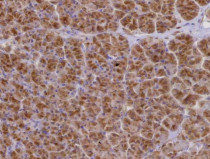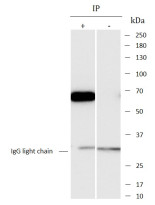ARG44756
anti-TRAF3 antibody
anti-TRAF3 antibody for IHC-Formalin-fixed paraffin-embedded sections,Immunoprecipitation and Human,Mouse
Overview
| Product Description | Mouse Monoclonal antibody recognizes TRAF3 |
|---|---|
| Tested Reactivity | Hu, Ms |
| Tested Application | IHC-P, IP |
| Host | Mouse |
| Clonality | Monoclonal |
| Isotype | IgG1 |
| Target Name | TRAF3 |
| Antigen Species | Human |
| Conjugation | Un-conjugated |
| Alternate Names | LMP1-associated protein 1; EC 6.3.2.-; CD40 receptor-associated factor 1; LAP1; CAP-1; CD40-binding protein; CAP1; CD40BP; IIAE5; CRAF1; CD40bp; TNF receptor-associated factor 3 |
Application Instructions
| Application Suggestion |
|
||||||
|---|---|---|---|---|---|---|---|
| Application Note | * The dilutions indicate recommended starting dilutions and the optimal dilutions or concentrations should be determined by the scientist. |
Properties
| Form | Liquid |
|---|---|
| Purification | Protein A purification |
| Buffer | PBS with 0.09% sodium azide |
| Storage Instruction | For continuous use, store undiluted antibody at 2-8°C for up to a week. For long-term storage, aliquot and store at -20°C or below. Storage in frost free freezers is not recommended. Avoid repeated freeze/thaw cycles. Suggest spin the vial prior to opening. The antibody solution should be gently mixed before use. |
| Note | For laboratory research only, not for drug, diagnostic or other use. |
Bioinformation
| Database Links | |
|---|---|
| Gene Symbol | TRAF3 |
| Gene Full Name | TNF receptor-associated factor 3 |
| Background | The protein encoded by this gene is a member of the TNF receptor associated factor (TRAF) protein family. TRAF proteins associate with, and mediate the signal transduction from, members of the TNF receptor (TNFR) superfamily. This protein participates in the signal transduction of CD40, a TNFR family member important for the activation of the immune response. This protein is found to be a critical component of the lymphotoxin-beta receptor (LTbetaR) signaling complex, which induces NF-kappaB activation and cell death initiated by LTbeta ligation. Epstein-Barr virus encoded latent infection membrane protein-1 (LMP1) can interact with this and several other members of the TRAF family, which may be essential for the oncogenic effects of LMP1. Several alternatively spliced transcript variants encoding three distinct isoforms have been reported. [provided by RefSeq, Dec 2010] |
| Function | Acts as a sequence specific DNA binding transcriptional activator or repressor. The isoforms contain a varying set of transactivation and auto-regulating transactivation inhibiting domains thus showing an isoform specific activity. Isoform 2 activates RIPK4 transcription. May be required in conjunction with TP73/p73 for initiation of p53/TP53 dependent apoptosis in response to genotoxic insults and the presence of activated oncogenes. Involved in Notch signaling by probably inducing JAG1 and JAG2. Plays a role in the regulation of epithelial morphogenesis. The ratio of DeltaN-type and TA*-type isoforms may govern the maintenance of epithelial stem cell compartments and regulate the initiation of epithelial stratification from the undifferentiated embryonal ectoderm. Required for limb formation from the apical ectodermal ridge. Activates transcription of the p21 promoter. [UniProt] |
| Cellular Localization | Cytoplasm. Endosome. Mitochondrion. Note=Undergoes endocytosis together with TLR4 upon LPS signaling (By similarity). Associated with mitochondria in response to virus. [UniProt] |
| Calculated MW | 64 kDa |
| PTM | Undergoes 'Lys-48'-linked polyubiquitination, leading to its proteasomal degradation in response to signaling by TNFSF13B, TLR4 or through CD40. 'Lys-48'-linked polyubiquitinated form is deubiquitinated by OTUD7B, preventing TRAF3 proteolysis and over-activation of non-canonical NF-kappa-B. Undergoes 'Lys-63'-linked ubiquitination during early stages of virus infection, and 'Lys-48'-linked ubiquitination during later stages. Undergoes both 'Lys-48'-linked and 'Lys-63'-linked ubiquitination in response to TLR3 and TLR4 signaling. Deubiquitinated by OTUB1, OTUB2 and OTUD5. [UniProt] |
Images (2) Click the Picture to Zoom In







